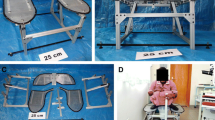Abstract
Introduction and hypothesis
This study investigated the effect of sitting and non-sitting postures on uroflowmetric parameters and postvoid residual urine (PVR) and women's preferred voiding posture.
Methods
Female university students (N = 45) voided on a modified sitting-type toilet in three postures: sitting, semi-squatting, and crouching over. Data on uroflowmetric measures were collected using a weight transducer urodynamic device and PVR was estimated by transabdominal ultrasound.
Results
Voiding in the three postures did not differ in terms of PVR and five of six uroflowmetric outcomes. However, “delay time to void” was significantly longer while semi-squatting than while sitting and crouching over. Furthermore, 51.1% of women had bell-shaped urinary flow curves while sitting, whereas only 22.2% and 17.8% did while semi-squatting and crouching over, respectively. Most women (88.9%) preferred a non-sitting posture when using a public sitting-type toilet.
Conclusions
Women's preferred non-sitting void posture on public sitting-type toilet should be a concern.



Similar content being viewed by others
References
Devreese AM, Nuyens G, Staes F, Vereecken RL, De Weerdt W, Stappaerts K (2000) Do posture and straining influence urinary-flow parameters in normal women? Neurourol Urodyn 19(1):3–8
Rane A, Corstiaans A (2000) Does leaning forward improve micturition? J Obstet Gynaecol 20(6):628–629
Wennergren HM, Oberg BE, Sandstedt P (1991) The importance of leg support for relaxation of the pelvic floor muscles. A surface electromyograph study in healthy girls. Scand J Urol Nephrol 25(3):205–213
Cai D, You M (1998) An ergonomic approach to public squatting-type toilet design. Appl Ergon 29(2):147–153
Moore KH, Richmond DH, Sutherst JR, Imrie AH, Hutton JL (1991) Crouching over the toilet seat: prevalence among British gynaecological outpatients and its effect upon micturition. Br J Obstet Gynaecol 98(6):569–572
Hong YJ, Chen YR, Huang SH (1996) A questionnaire survey of users and managers of public toilets. Gend Space Team Commun 3:46–66
Gupta NP, Kumar A, Kumar R (2008) Does position affect uroflowmetry parameters in women? Urol Int 80(1):37–40
Unsal A, Cimentepe E (2004) Voiding position does not affect uroflowmetric parameters and post-void residual urine volume in healthy volunteers. Scand J Urol Nephrol 38(6):469–471
van Haarst EP, Heldeweg EA, Newling DWW, Schlatmann TJM (2005) A cross-sectional study of the international prostate symptom scores related to age and gender in Dutch adults reporting no voiding complaints. Eur Urol 47(3):334–339
Abrams P, Cardozo L, Fall M, Griffiths D, Rosier P, Ulmsten U, Van Kerrebroeck P, Victor A, Wein A (2003) The standardisation of terminology in lower urinary tract function: report from the standardisation sub-committee of the International Continence Society. Urology 61(1):37–49
Schafer W, Abrams P, Liao L, Mattiasson A, Pesce F, Spangberg A, Sterling AM, Zinner NR, van Kerrebroeck P (2002) Good urodynamic practices: uroflowmetry, filling cystometry, and pressure-flow studies. Neurourol Urodyn 21(3):261–274
Haylen BT, Ashby D, Sutherst JR, Frazer MI, West CR (1989) Maximum and average urine flow rates in normal male and female populations–the Liverpool nomograms. Br J Urol 64(1):30–38
Haylen BT, Yang V, Logan V (2008) Uroflowmetry: its current clinical utility for women. Int Urogynecol J Pelvic Floor Dysfunct 19(7):899–903
Drach GW, Ignatoff J, Layton T (1979) Peak urinary flow rate: observations in female subjects and comparison to male subjects. J Urol 122(2):215–219
Kuo HC (1994) Urodynamic findings in normal females in Taiwan. Tzu chi Med J 6(3):163–169
Kuo HC (2003) Videourodynamic results in stress urinary incontinence patients after pelvic floor muscle training. J Formos Med Assoc 102(1):23–29
Jorgensen JB, Jensen KME, Klarskov P, Inge B, Ivan A, Mogensen P (1990) Intra- and inter- observer variations in classification of urinary flow curve patterns. Neurourol Urodyn 9(5):535–539
Wennergren H, Larsson LE, Sandstedt P (1989) Surface electromyography of pelvic floor muscles in healthy children. Methodological study. Scand J Caring Sci 3(2):63–69
Liao Y-M, Dougherty MC, Biemer PP, Boyington AR, Liao C-T, Palmer MH, Lynn MR (2007) Prevalence of lower urinary tract symptoms among female elementary school teachers in Taipei. Int Urogynecol J Pelvic Floor Dysfunct 18(10):1151–1161
Moller LA, Lose G, Jorgensen T (2000) The prevalence and bothersomeness of lower urinary tract symptoms in women 40–60 years of age. Acta Obstet Et Gynecol Scand 79(4):298–305
Swithinbank LV, Donovan JL, du Heaume JC, Rogers CA, James MC, Yang Q, Abrams P (1999) Urinary symptoms and incontinence in women: relationships between occurrence, age, and perceived impact. Br J Gen Pract 49(448):897–900
Zhang W, Song Y, He X, Xu B, Huang H, He C, Hao L, Li Y (2005) Prevalence and Risk Factors of Lower Urinary Tract Symptoms in Fuzhou Chinese Women. Eur Urol 48(2):309–313
Acknowledgements
This research was supported by China Medical University (CMU 95-207), Taiwan, Republic of China, where the corresponding author (SYC) previously served. The authors also wish to express their greatest gratitude to the study participants for their time and Dr. Wen-Ming Liang for her statistical advice.
Conflicts of interest
None.
Author information
Authors and Affiliations
Corresponding author
Rights and permissions
About this article
Cite this article
Yang, KN., Chen, SC., Chen, SY. et al. Female voiding postures and their effects on micturition. Int Urogynecol J 21, 1371–1376 (2010). https://doi.org/10.1007/s00192-010-1204-3
Received:
Accepted:
Published:
Issue Date:
DOI: https://doi.org/10.1007/s00192-010-1204-3




